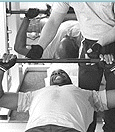 | Weight lifting techniques |
 Proper Lifting Technique
Proper Lifting Technique
The technique incorporated into lifting weights is the most important part of weight training. Improper technique can be responsible for everything from unintentionally exercising
the wrong set of muscles to an injury requiring surgery and possibly years of recovery. Tears can occur in muscles, tendons, and ligaments.
Joints can be damaged with possible chronic implications. Technique can be learned from reading exercise magazines or books specifically geared to weight room technique. However, in most cases,
a few initial trips to the weight room with a Certified Personal Trainer can be extremely helpful to get you started on the proper exercises with respect to your goals and instruct you on proper technique.
The following rules should be followed:
Lift Weights from the floor with legs and not the
back.
Use a smooth full range of motion.
Don't jerk the weights.
Don't lock the knees (keep them slightly bent).
Don't put pressure on the teeth, the enamel can crack.
Keep back alignment, don't hyper extend or flex the back.
Don't chat with your buddy, concentrate on the task.
Unoxygenated muscles can cramp, breathe on
exertion.
Sets And Repetitions
A Repetition is referred to as a Rep and is a single lift of the weights. A group of Reps are called a Set. An exercise is generally composed of 3 to 4 Sets.
The amount of weights to use is dependent on the goal of the participant and the fitness level. If the goal is to build muscle at the fastest rate then 6 to 8 Reps should be done with a heavier weight. If the goal is to simply tone or maintain the existing muscle strength then 12 to 16 Reps should be done with a lighter weight.
Participants should never use the heavy weight category if
they have not lifted before or if significant amount of time
has passed since they have last trained. When initially
beginning a training program it is recommended to use the
Light category for a least 3 to 4 weeks before progressing
to the medium weight level.
There are various methods for determining the amount of
weights to incorporate into a training effort (Heavy, Medium,
Light). The 1 Repetition Maximum (1RM) method is
determined by the highest weight that one can lift only once
and not again. A percentage of this 1RM value is then
calculated to use for multiple Reps and Sets. For example if
the participant can bench press 150 lbs as a maximum
effort and only once then the 1RM is 150 lbs. A percentage
of this weight is used for the full complement of Reps and
Sets. For the Light category, 50% of the 1RM is used.
Another method that can be used to determine the weight to
use for a particular exercise is to simply estimate the initial
weight. Do as many as you can. If your goal is to build
muscle at the fastest rate, then if you can do more than 8
Reps then the weight is too light. If you can't do more than 6
Reps, then the weight is too heavy.
The following table details the number of Reps to use
depending on the participants strength training goals. In each case perform 3 to 4 Sets.
| Type of workout |
Weight level |
Reps |
% of RM |
Rest period |
| Strength |
Heavy |
6-8 |
85-90% |
2-3 minutes |
| Power |
Heavy |
6-8 |
80-90% |
2 minutes (faster) |
| Building/Toning |
Medium |
8-12 |
70-80% |
1 minutes |
| Endurance |
Light |
12-20 |
50-65% |
30 seconds |
Variations of Sets And Repetitions
Form is critical in all weight training
and particularly for each of the following variations.
One Set - One set for each exercise.
One or more exercises may be selected for each body part in training.
Excellent for beginners and those with lack of
time.
Three Set - Three set for each exercise
Provides good results for most people
regardless of their fitness goals.
Most commonly used system.
Split Routine - Alternate training days of specific
muscle groups.
Never train same muscle groups two days in a row.
Greater workout intensity possible.
Pyramid Set - Begin with heavy weights and low reps and end with high reps and low weight.
Increases stamina.
Heavy Set - Begin with a warm-up set of less than
50% of the intended maximum weight. Continue
increasing the weight in each set to near maximum
until the weight can be lifted a maximum of 4 reps.
Increases peak power.
Super Set - Two exercises for one body part done
consecutively with no rest in between. This technique can be applied to opposing muscles, i.e. quadriceps and hamstrings.
Compound Sets - A superset for the same body part. A good example
would be squads followed by leg curl.
Keep rest between exercises to a minimum for the following to keep intensity
level high for strength.
Tri Set - Three consecutive exercises for the same
body part.
Giant Set - Four consecutive exercises for the same body part.
|